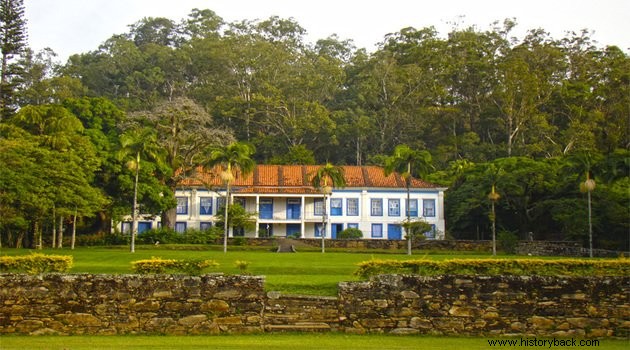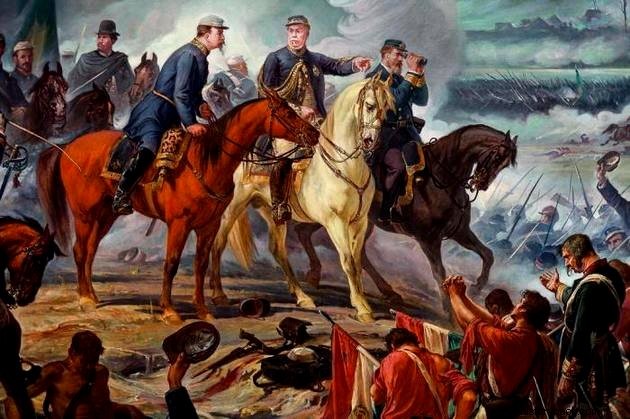The Second Reign corresponds to the period from July 23, 1840 to November 15, 1889, when Brazil was under the reign of D. Pedro II (1825-1891).
It was characterized as a time of relative peace between the Brazilian provinces, the gradual abolition of slavery and the Paraguayan War (1864-1870).
It ends with the republican coup on November 15, 1889.
Summary of the Second Reign
The Second Reign is the moment when Brazil consolidates itself as a nation.
The political regime of the country was the parliamentary monarchy, where the Emperor chose the President of the Council (equivalent to the position of Prime Minister) through a list with three names.
At the economic level, coffee acquires fundamental importance, being the most exported product by Brazil. The first railways and steamboats arrive with the aim of improving the circulation of the so-called "black gold".
In the midst of coffee prosperity, Brazil finds itself in a dilemma, as those who worked on coffee plantations were enslaved people. Since the government of Dom João VI, the country had committed itself to abolishing slavery. However, the coffee elite was opposed, as this would entail economic losses. The solution is to end menial work gradually.
It will be in the Second Reign that Brazil is faced with the biggest armed conflict in South America:the Paraguayan War.
Finally, without support from rural elites and the army, the monarchy is overthrown in a military coup. The Imperial Family is forced to leave the country and the republic is installed.
Politics in the Second Reign
The Second Reign begins, in 1840, with the Coup of Majority.
During the regency period, Brazil experienced a series of civil wars. With this, the Liberal Party proposes the anticipation of the majority of the heir to the throne, Dom Pedro. Some politicians understood that the lack of a central government was a danger to the unity of the country.
The politics of the Second Reign is marked by the presence of two political parties:
- the Liberal Party , whose members were known as the “luzia”;
- the Conservative Party , whose members were known as the “saquarema”.
Strictly speaking, both parties defended elite ideas, such as maintaining slavery. They only differed in relation to central power, with liberals fighting for more provincial autonomy and conservatives for more centralization.
Due to his father's abdication, D. Pedro II felt the need to change the form of government. Therefore, in 1847, he implants parliamentarism in Brazil.
Here, the system worked a little differently from the one practiced in England. There, the prime minister was the deputy of the most voted party.
In Brazil, the President of the Council (prime minister) was chosen by the Emperor from a list with three names. This system became known as reverse parliamentarism.
The Emperor also held the Moderating Power, but it was used only a few times by the sovereign.
Compared to the regency period (1831-1840), there were not many internal conflicts during the Second Reign. However, we can cite some revolts such as:
- the Praieira Revolution, 1848-1850, in Pernambuco,
- the Muckers Revolt, in Rio Grande do Sul, in 1873-1874
- the Quebra-Quilos Revolt, in the northeast region, in 1872-1877.
Economy in the Second Reign

At that time, the excellent planting conditions in Vale do Paraíba (RJ) boosted coffee production and exports. Later, coffee plantations would spread across São Paulo.
Brazil began to export more than to import and the demand for coffee was so great that there was a need to increase the workforce.
However, in order to protect their businesses, coffee planters frowned upon attempts by any law that favored the abolition of slavery. Therefore, the landowners support the arrival of immigrants, especially Italians, to work in the coffee plantations.
As a result of the growth of coffee exports, the first railroads were built and cities were born. The ports of Santos and Rio de Janeiro are thriving.
At that time, the first factories began to be set up in Brazil, albeit in isolation and largely due to the work of the Barão de Mauá.
See also:Coffee CycleAbolitionism in the Second Reign
This time is crucial for the process of abolition of enslaved people, as there are several societies and newspapers against this practice. Slaves are mobilized through quilombos and religious brotherhoods, but they also request their freedom in court.
The abolition of slavery was not wanted by the planters. These would lose the investment in the purchase of enslaved people and would have to start paying wages, thus reducing their profit margin.
In this way, they fight for the government to pay compensation for each freed slave.
Since compensating farmers was out of the question, the government enacts laws aimed at gradually abolishing menial labor. They are:
- Eusébio de Queirós Law (1850);
- Law of the Free Womb (1871);
- Sexagenarian Law (1887);
- Golden Law (1888).
Foreign Policy in the Second Reign

War of Paraguay (1864-1870)
At the international level, Brazil was involved in friction with its neighbors, especially in the La Plata region.
In response to the invasion of Rio Grande do Sul, the imperial government declares war on the Paraguayan dictator Solano López (1827-1870), in the episode known as the War of Paraguay. The conflict would still count on the participation of Argentina and Uruguay, and would last about five years.
Paraguay was defeated and Solano López killed by Brazilian soldiers. The Army saw itself strengthened after the conflict and began to claim more space in national politics.
Christie Question
In the same way, the government was involved in the Christie Question (1863-1865) when there were incidents with British citizens on Brazilian soil. It is important to remember that British subjects were not judged by Brazilian courts if they committed a crime in the Empire of Brazil.
The Christie Question began with an altercation between British sailors and officers in Rio de Janeiro and the invasion and confiscation of five boats in the port of Rio de Janeiro by a British frigate.
The Brazilian government asked those responsible to respond in court in the country and that compensation be paid. Faced with the British refusal, Brazil broke diplomatic relations with the United Kingdom for two years.
End of the Second Reign and the Proclamation of the Republic
During his government, D. Pedro II opposed the church, the military and the rural elite. All this was removing the support of the country's important figures from the throne.
Some episodes turned events towards a military coup. Examples are the requirement that the church not comply with papal orders, without them having been approved by the emperor, in what has gone down in history as the Religious Question.
However, it was the devaluation of the military and the end of slavery that most bothered the elites and forced their deposition.
The military demanded more recognition, salary increases and promotions that were not carried out. All this made some officers adhere to republican ideals.
Likewise, the landowning elite could not bear the idea of abolition of slavery.
Thus, the Republic is instituted, without popular participation, on November 15, 1889 by Marshal Deodoro da Fonseca, who was the first president of Brazil.
See also:Proclamation of the Republic (1889) There are more texts on the subject for you:
- Majority Strike
- Monarchy
- Regency Period
- Old Republic
